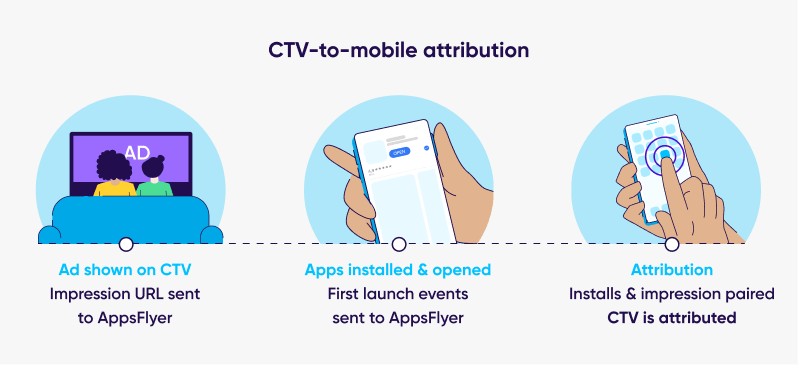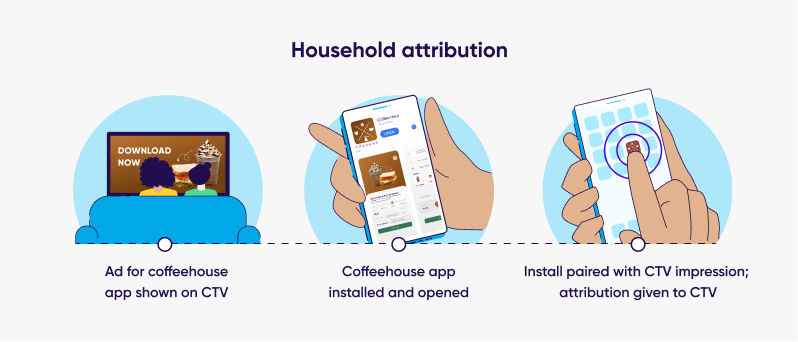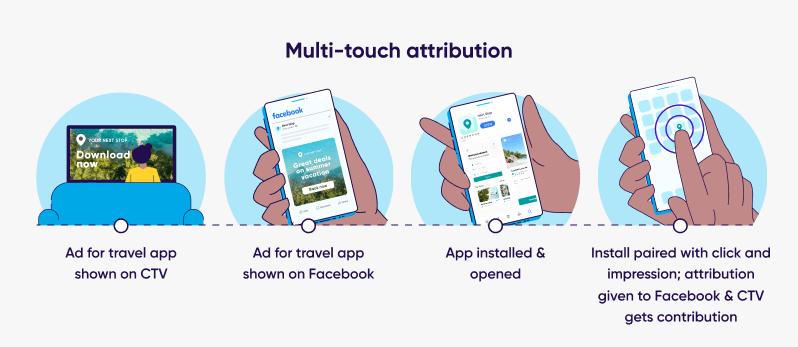
Measure CTV ad impact today with CTV-to-mobile attribution
![7962 [CTV-to-mobile] 1200x1200 (1) CTV-to-mobile attribution featured](https://www.appsflyer.com/wp-content/uploads/2022/09/7962-CTV-to-mobile-1200x1200-1.jpg)
There’s never a dull moment in the TV industry, and that’s largely due to the convergence of technology and entertainment playing out in the connected TV (CTV) space.
With the convenience and instant gratification it offers, CTV is seeing explosive growth among viewers worldwide. And this popularity, in turn, has created an appetite among advertisers to get in front of a growing consumer audience.
What makes CTV so compelling for advertisers is simple. The dovetailing of traditional TV and the internet has transformed the medium into a new performance channel. And for advertising brands, that means not only visibility and accurate measurement — but a recent lowering of cost barriers and a newfound ability to target audiences better than with linear TV.
“The dovetailing of traditional TV and the internet has transformed the medium into a new performance channel.”
Today, we’re pleased to announce that all of these benefits of CTV – the ability to accurately measure campaigns and show ads to the right audience at relatively low cost points — are available to mobile marketers.
With AppsFlyer’s CTV-to-mobile solution, mobile marketers can leverage CTV as a channel for growth by attributing mobile app conversions to campaigns they run on CTV and measuring their CTV activities alongside other marketing efforts.
Not your parents’ TV ads
What’s so significant about today’s announcement? In a nutshell, mobile marketers can now hitch their wagons to the rapidly growing CTV growth engine, a welcome addition to the marketing mix given the saturated state of mobile inventory.
CTV is gaining popularity among brands, with ad spend set to grow at nearly 20% annually in the US, because it’s evolved in sophistication and accessibility to advertisers.
On the one hand, the traditional advertising model is alive and kicking: we’ll certainly continue watching commercials on CTV devices, smart TVs, and gaming consoles (or alternatively subscribe to premium services to avoid watching ads).
On the other hand, the industry has evolved. Gone are the days when TV advertising was the preserve of large brands with deep pockets, a situation that held true from the early days of TV advertising until recently.
CTV has changed the rules of engagement, and brands of all sizes — small, medium, and large — can now treat television as a performance channel. What’s even more significant, brands, including mobile brands at various stages, can flip on CTV as a channel to:
- Target large audiences with precision
- Measure the impact of television campaigns on installs, in-app events, LTV, and more
- Drive household acquisition
- Gain access to new, more affordable TV inventory
How CTV-to-mobile attribution works
The CTV-to-mobile attribution flow, which begins with a CTV commercial and continues with one or more mobile app conversions, is relatively straightforward:

There are a couple of important points to mention:
- One or more installs can be attributed to one CTV ad. This means that if, say, three people watch an ad, and they all download and install the app, attribution for the three installs will be given to the CTV ad.
- Viewers with iOS, Android, and Windows that watch an ad and then install the app via their respective app stores — will all be attributed to the same CTV ad.
Leveraging CTV-to-mobile attribution
CTV-to-mobile attribution opens up new avenues for mobile marketers because it transforms CTV into a measurable digital channel for mobile growth.
Not only can marketers gauge campaign impact, they can now use CTV platforms and CTV networks to better target relevant audiences. Conveniently, these CTV platforms and ad networks can be measured like any other mobile marketing partner.
But it doesn’t stop there. Brands can now:
- Accurately measure events and track KPIs
One reason mobile marketers have yet to opt for CTV advertising is that until now measuring impact was difficult to impossible.
With CTV-to-mobile attribution, marketers can measure campaign effectiveness and have a full view of their funnel, from ad impressions to app installs to in-app events and revenues.
Marketers can also see if a CTV ad contributed to a mobile conversion, for example in a case where a viewer watched a CTV ad and shortly thereafter clicked on an ad and installed the app.
This crucial visibility opens the aperture to tracking KPIs such as LTV and ARPU.
- Optimize campaigns
Being able to measure success and failure also means that campaigns can be optimized.
The dust is far from settling on the dynamic CTV ecosystem — so it’s important to explore different platforms, streaming apps, and CTV networks, and understand their strengths, weaknesses, and product roadmaps.
With the lower costs offered by CTV, marketers can test ads with different age groups, creatives, segments, and ad types. Experimenting and iterating will be part and parcel of advertising on CTV given the dynamic state of the ecosystem.
- Drive household acquisition
CTV presents a unique opportunity for advertisers — since friends and family often watch TV together, frequently with a mobile device in their hands. Advertisers can make the most of this group TV-watching dynamic by showing ads to multiple people at once.
In other words, as opposed to one-to-one marketing characterizing social media and email, CTV advertising has the powerful multiplier effect of one-to-many marketing.
In this way, marketers can leverage CTV to increase household attribution and push revenues, LTV, and in-app events within a given home.
Interested in advertising on CTV and don’t know where to start?
Learn about next steps & best practices in this guideUse cases
So, how can you leverage CTV-to-mobile? Here are two examples to help you understand how to measure the impact of CTV campaigns on mobile growth:
Use case 1: Household attribution
In this use case, a marketer at a specialty coffeehouse chain thinks that viewers of a show focused on coffee making across the globe will be searching for a way to quench their thirst for a cup of high quality java by the show’s end.
She runs an ad towards the end of the show showcasing hot and cold beverages. At the end of the spot, the ad encourages viewers to download the app.

One of the viewers takes their mobile devices and heads to the app store to download and open the app.
The install is matched with the CTV ad view, and attribution is given to CTV.
Use case 2: Multi-touch attribution
A travel app marketer decides to show an ad during popular travel shows. The ad features alluring emerald green beaches and invites viewers to download the app.
A viewer sees the CTV ad, but doesn’t act on it. A few hours later, she sees a Facebook ad for the travel app with the same beautiful turquoise water. She clicks on the ad and installs the app.

In this case, the Facebook click wins attribution, while the CTV view is given contribution.
What’s next?
Now that you have a good idea of what you can do with CTV-to-mobile attribution, it’s time to contact your CSM to explore next steps.
If you’d like more information on how to get started with CTV advertising, we’ve put together this handy guide to get you on your way.



